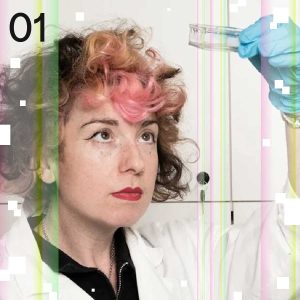
Charlotte Jarvis works between art and science. She has recorded music onto DNA, seen her heart beat outside of her body and grown her own tumor. Charlotte’s work explores the future of reproduction and the body as a liminal space - a site for transformation, hybridisation and magic. Charlotte is currently engaged in making “female” sperm with scientists in Leiden, a “collaborative uterus” with a team in Argentina and an artificial embryo model “parented” by an artificial intelligence in Denmark. Charlotte has exhibited her work in twelve international solo shows and over one hundred group exhibitions. She currently lectures at The Royal College of Art in London.

Dr. Patricia Saragüeta has a degree and PhD in Chemistry. She is a CONICET Researcher and Professor at the Department of Physiology and Molecular and Cellular Biology, School of Exact and Natural Sciences, UBA. She is a scientist and artist, interested in genomics, cellular and molecular biology. She works for the meeting of art and science both in her work and at the institutional level. She has published three books of poetry, several articles and many essays.
2022-
mixed media
Organ of Radical Care: Una Matriz Colaborativa is an ongoing collaborative project using new science to grow a collaborative uterus from the menstrual blood of multiple women, trans and non-binary people, in which a fertilized egg could grow.
The chalice on display houses a cell colony, consisting of endometrial cells derived from multiple anonymous donors. The team have successfully grown endometrial organoids (‘mini-wombs’) in the lab, and the next stage of the project is to gain ethical approval to use menstrual blood from a group of 13 Argentinian activists who have volunteered to be the project donors.
The donors recite together a poem written for the project. Video works depict these donors, the scientific process, Patricia’s laboratory, cell samples and also document Charlotte and Patricia bringing some of the samples to Tierra del Fuego in Patagonia—the literal end of the world—which stands here as a symbolic “portal” to the desired future. The project aims to be what Donna Haraway describes as “split and contradictory”; to generate “rational conversations and fantastic imaginings that change history.”
The work is being realized within the framework of the European Media Art Platforms residency program at Ars Electronica with support of the Creative Europe Culture Programme of the European Union. Additional support from MU Hybrid Arthouse, the Royal College of Art, IBYME-CONICET and FBMC-FCEN-UBA. This project is funded and presented in the context of the EMAP project co-funded by the Creative Europe Programme of the European Union.
The work is being realized within the framework of the European Media Art Platforms residency program at Ars Electronica with support of the Creative Europe Culture Programme of the European Union. Additional support from MU Hybrid Arthouse, the Royal College of Art, IBYME-CONICET and FBMC-FCEN-UBA. This project is funded and presented in the context of the EMAP project co-funded by the Creative Europe Programme of the European Union.
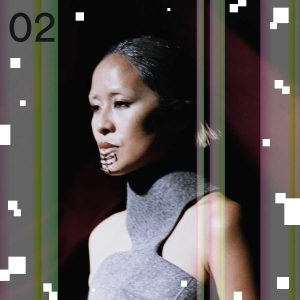
Corin Ileto is a Filipina-Australian composer, producer, and performer merging traditional forms with hyper-digital sounds to create new imaginary realms. Tristan Jalleh is a Malaysian/Australian Multimedia Artist and Director, known for creating large-scale projections of immersive digital environments. Together, they have created numerous video works and live audiovisual music performances that have been presented internationally.
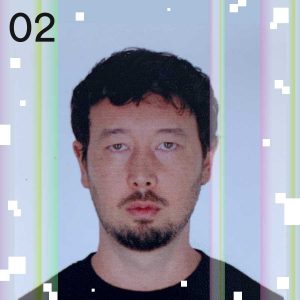
Tristan Jalleh is a Malaysian/Australian multimedia artist and music video director based in Bangkok. He frequently collaborates with artists and musicians to create hybrid digital artworks for art galleries, festivals, and live performances. Jalleh is also a member of the Club Até Collective, founded by Bhenji Ra and Justin Shoulder.
Recent exhibitions and collaborations include NUWRLDS at 4A Centre for Contemporary Asian Art Sydney, NOVA Biennial Rio of Art & Technology Brazil, FASHION X AI at M+ Museum 2022 (Hong Kong); Ultra Unreal at MCA Sydney; In Muva We Trust digital projection at BirminghamMuseum & Art Gallery (England), TRAMWAYS (Scotland), and the National Gallery of Australia; CORIN at FIBER Festival 2022 (Amsterdam); Eye See You Magik with Hannah Bronte at NGV Triennial; Sydney Opera House (Shortwave Program); MONA FOMA; Sydney Biennale; Australian Centre for Photography 2020; AsiaTOPA Festival at the Australian Centre for Moving Image in 2017 and 2019; Melbourne RISING Festival 2021; Heart Of Cyberpunk fashion festival 2021 (Hong Kong); Vincom Centre for Contemporary Art 2020 (Vietnam), and more.
2024
Video Installation, Keyboard sculpture (recycled piano keys, acrylic paint, wax)
2’54”
Electronic producer Corin Ileto performs a celestial soundtrack in a hybrid virtual world created by multimedia artist Tristan Jalleh, that combines baroque, anime, and sci-fi film aesthetics. Inspired by the ‘hydraulis’ (ancient water organ), Ileto is interested in the idea of musical instruments as spirits and sacred objects. Transcending the boundaries between the physical and virtual, the instrument merges CGI animations by Jalleh with a keyboard prop that Ileto built from the remnants of an abandoned piano.
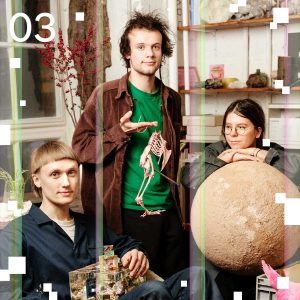
Nonhuman Nonsense is a research-driven art and design collective working in the realm of social dreaming and world-making. Their projects engage with the nonhuman: animals, objects, ecology, technology, and the spectres between and beyond categories.
They use nonsense as an antidote to “common sense” – embracing paradoxical stories to explore the ethical and metaphysical layers of our relationship with the (nonhuman) world. The collective creates contradictory scenarios and propositions in which they appropriate ideas from fields such as science, computing, law and mythology.
Nonhuman Nonsense enjoys curiosity, cherishes compassion, and recognises that separating the human from the nonhuman is nonsense.
2022
seashells, prints, aquariums, electronics, test tubes, concrete, etc
A contemporary temple to a long-forgotten goddess of the Zeeland sea, where she emerges as a 21st-century hydrofeminist. In collaboration with scientists from the Royal Netherlands Institute for Sea Research (NIOZ), the project advocates for soft, natural borders between land and water, rather than hard dykes and barriers.
Amidst the climate crisis, countries below sea level, like the Netherlands must reform their relationship with the sea to avoid catastrophic flooding. The project highlights the importance of returning reclaimed land to mudflats and salt marshes, coastal ecosystems that naturally protect from rising seas and floods.
By resurrecting the ancient goddess Nehalennia, the project blends science and mythology, offering a narrative about coexistence in times of a paradigm shift. It contributes to a global discourse in which the climate emergency forces us to re-evaluate our entire relationship with non-human beings and forces.
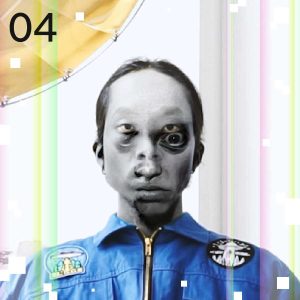
Hung-Lu Chan is a Taiwanese artist and social designer, based in the Netherlands, interested in exploring human imaginations of the unknown from within. In his recent projects, he particularly takes aliens as a metaphor and researches their fluid interpretations and sociopolitical impacts on our perceptions of otherness by combining neuroscience and spirituality. His creative practice is rooted at the intersection of art, science, and technology, excelling in using interactive experiences to contextualize alternative viewpoints and questions about the unknown world. He positions his work as an 'imagination catalyst' to challenge established stereotypes and norms and prompt diverse and inclusive imaginations of humanity.
2023
brain image, AI image generators, installation
Triggered by curiosity, humans tend to imagine aliens in an approach to perceiving the unknown. However, these absurdities are entirely shaped by our preconceptions. Delving into various representations of aliens, this project highlights how we visualize otherness by looking within ourselves. With the means of fMRI and ChatGPT, our imagination of aliens will be explored personally and collectively by conducting guided meditation with three individuals and one AI. Ultimately, a liminal space is developed to visualize aliens from both human and artificial inner worlds, inviting audiences to appreciate others' inner aliens and prompting them to introspect on their cognitive biases and perceptions of the unknown.

Chuan-Lun Wu born in Tainan, Taiwan. The ever-changing dynamics, compromises and contradictions informing the relations between nature and civilization, ecology and politics as well as materials and the digital realm, have formed the backdrop for Wu's artistic practice. He employs a diverse media and technics, including computer-generated imagery, photography, drawing, 3D printing, found objects, and porcelain, to create conceptual and research-based installations. His recent work often uses the process of collecting/gathering as a point of departure to explore the identity and meaning of the collected/gathered objects, from which he gradually unravels the underlying, entangled historical and social context.
19.7×30.3 cm
2022、2024
Pencil, color pencil, marker pen, gel pen, acrylic ink, paper
19.7×30.3 cm
2022
Tempera, video, pottery collection, resin
A series of paper sketches titled An Eggy Video Meeting, inspired by the video meetings that have become the post-pandemic norm, appropriates video as the most common communication interface during the pandemic era. From a nonhuman perspective, can observing nature not also be a form of social awkwardness for nonhuman entities? Uterus Is a Kiln, Egg Is Fired (tentative) starts from a ceramic collection of a hoopoe produced in East Germany, using egg tempera and animation as mediums to present contrasts between the internal and external, egg and ceramic, as well as digital and painting.
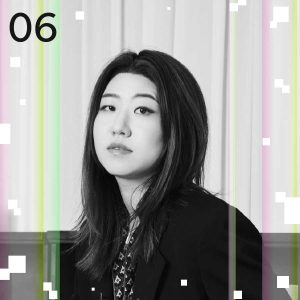
Sunjeong Hwang is a contemporary artist and new media composer whose work explores the interplay between post-humanism, technology, and ecological systems. Through interdisciplinary research, she synthesizes sound, AI, generative coding, and audiovisual installations, weaving together organic and technological elements to reveal the resonance between human and non-human entities. By pushing the boundaries of sensory perception and futuristic interfaces, Hwang creates multisensory environments that serve as critical interfaces, deepening engagement with the evolving relationship between nature, technology, and post-human existence. Hwang’s practice, spanning sound production, exhibitions, and live performances, is showcased globally. Her works have been exhibited at SeMA, Art Center Nabi, ACC, and more. Recognized, Awarded by ISEA 2023 (Paris), Future Tense (Hong Kong), and as a SONGEUN Art Award finalist, she has also presented her sound and AV performances at UKAI Project (Toronto), Prectxe, Tokyo TDSW, and Mutek JP+MX.
2024
Video
19’14”
Sunjeong Hwang’s work involves interdisciplinary research with various collaborators, utilizing new media, installation, and artificial intelligence. Her piece, Telluric Memories: Warm Woven Clicks and Entangled Radiant explores the intricate relationship between humans, nature, and technology, aiming to liberate the senses and renew memory within the Tanhamu universe. Tanhamu, derived from the Sanskrit word tanha (desire) and the Chinese character mu (dance), is part of Hwang’s ongoing series that uses mycelium as a motif for movement. Through this, the work poetically addresses the ecological and climate crises, blending mycelium research with Indigenous methodologies to contemplate symbiosis and the Anthropocene. Combining sound installation, choreography, digital shamanism, and poetry, it evokes warm sensations through sensory encounters that highlight the connection between humans and non-humans, fostering a symbiotic ecosystem of shared memories and energies.
(Telluric Memories, woven from the warmth of Tanhamu Series, 2021, 2022, 2023
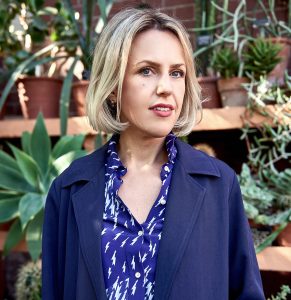
The recipient of the S+T+ARTS Grand Prize 2023 for Artistic Exploration, Alexandra Daisy Ginsberg is a multidisciplinary artist examining our fraught relationships with nature and technology. Through subjects as diverse as artificial intelligence, synthetic biology, conservation, and evolution, she explores the human impulse to "better" the world. She experiments with simulation, representation, and the nonhuman perspective to question the contemporary fixation on innovation over conservation, despite the environmental crisis. Her work is in collections including the Art Institute of Chicago, the Cooper Hewitt Smithsonian Design Museum, and ZKM Karlsruhe. In 2021, she launched Pollinator Pathmaker, a series of living artworks for pollinators, planted and cared for by humans with the long-term desire to create the world’s largest climate-positive artwork. Her stained glass commission for Manifesta 15 Barcelona Metropolitana was just unveiled at The Three Chimneys power station and in October 2024, she will open her first Swedish solo exhibition, “Machine Auguries” at Bildmuseet, Umeå.
2023
Serpentine and LAS Editions
Looped video dimensions variable
3’45”
Pollinator Pathmaker is an artwork for pollinators, planted and cared for by humans. Created by Alexandra Daisy Ginsberg in response to human-made ecological damage, the work is a one-of-a-kind experiment in interspecies art. This video artwork shows the Pollinator Pathmaker Serpentine and LAS Editions that were planted in London (UK) and Berlin (DE). The artist’s bespoke software composites her digital paintings of each plant species in these Editions, and the individual images are automatically assembled into a virtual garden, based on the algorithmic planting designs. We experience this otherworldly space shot from the perspective of a foraging insect, rather than from the top-down view of a human. The scenes flip between human view and the artist’s “pollinator vision” simulation. But capturing an insect’s worldview is impossible, so we can only experience the digital distortion of a virtual environment.
Pollinator Pathmaker was originally commissioned by the Eden Project and funded by Garfield Weston Foundation.
Founding supporters Gaia Art Foundation, Google Arts & Culture.
International Edition Founding supporter LAS Art Foundation.
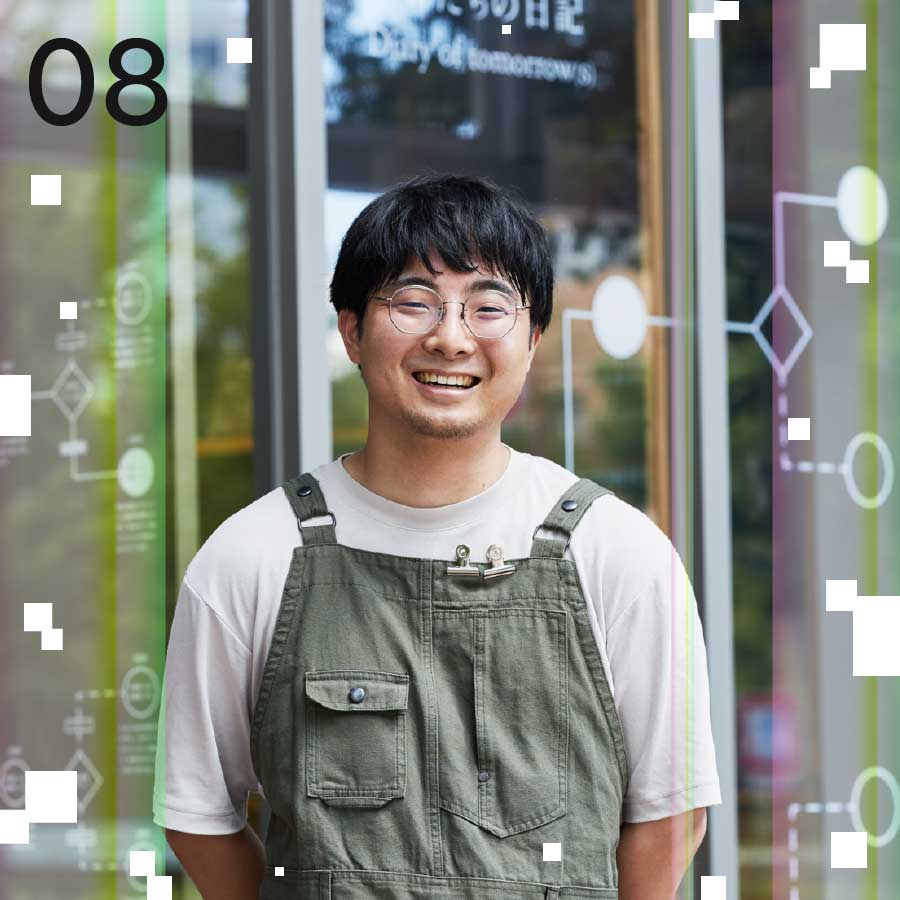
Tomo Kihara is an artist and game developer creating experimental games and public installations. His work often takes the form of embodied playable thought experiments that invite everyone to explore new questions around socio-technical issues through play. Recent projects focusing on AI's social impact have been developed in collaboration with institutions such as Waag Futurelab (Amsterdam) and the Mozilla Foundation (USA). His works have been exhibited at the Victoria & Albert Museum (London, 2022) and the Asian Art Museum (San Francisco, 2024).
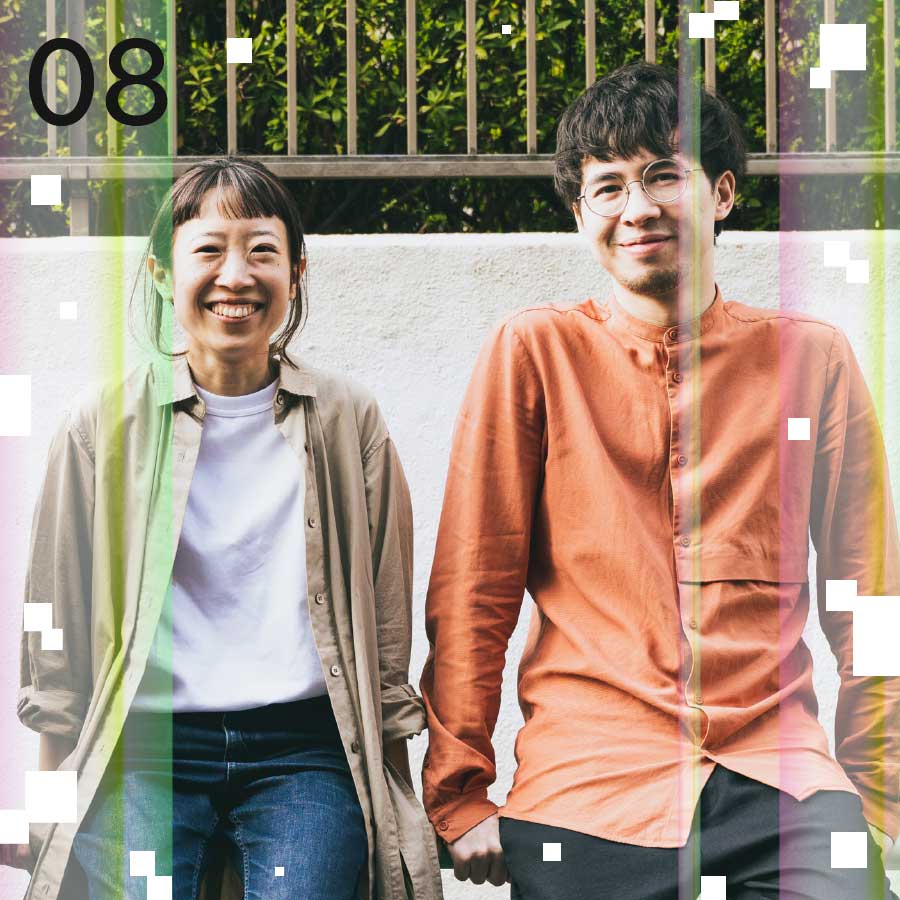
Playfool is an art-design unit by Daniel Coppen (UK) and Saki Maruyama (JP). With a combined background in design and engineering, their work explores the relationships between society and technology through the medium of play. Their multidisciplinary and experimental practice comprises objects, installations, and multimedia productions, which emphasize play's experimental, reflective and intimate qualities. Playfool’s works have been awarded in both the Dezeen Award (2021) and STARTS Prize (2024), and have been exhibited at the Victoria and Albert Museum (London, 2023) and Ars Electronica (Linz, 2024).
2022-2024
Screen, iPads, computer
outdraw.AI and is a game where you must draw the prompt in an unusual way so that other humans can guess what it is, but the image recognition AI can’t. In each round, one player chooses a prompt and attempts to create a drawing that's just clear enough for humans but confusing to the AI. Once the drawing is complete, all participants, including the AI, attempt to guess
the subject. Humans win the round if at least one of them guesses correctly while the AI fails. However, if the AI guesses correctly, all the humans lose that round.
This game is part of the broader "Deviation Game" series, which explores the dynamic relationship between human creativity and AI. Expanding on Alan Turing's Imitation Game (1950), the series aims to utilize AI not to imitate humanity's past expressions, but rather to identify established expressions, allowing humans to deviate from the past and expand the horizons of artistic possibility.
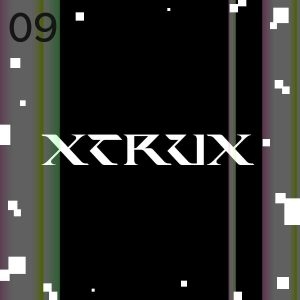
XTRUX focuses on transformations in life brought about by digital identity and the expansion of image boundaries guided by technology. They specialize in game engines, motion capture, audiovisual spatial sculpture, and interactive installations, creating new forms of virtual and immersive media exhibitions. Since its establishment in 2020, XTRUX has launched immersive parties that combine technology and experimental electronic music, emphasizing interdisciplinary collaboration. They were one of the resident artists at Digital Art Center (Taipei) in 2023-2024. Their works have participated in events such as the LEV Festival in Spain, the Linz Electronic Arts Festival, the TCCF Creative Content Conference at the National Culture and Arts Foundation, and the C-LAB Sound Art Festival.
2024
Game engine, 3D printing, mixed media, video
Black Museum features sculptures and a real-time game built with game engines, blending images and spatial constructions into large-scale installations. It explores the dialectical interaction between the virtual and the real in the contemplation of perception. In humanity's pursuit of technology, the initial focus is on technology and aims to replace labor, or perhaps surpass life itself. After this, what should humanity pursue? This art installation shows a person pushing a rock, but the destination of the stone remains uncertain. This act illustrates an endless process of pushing it somewhere, yet also resembles being stuck in this phase.
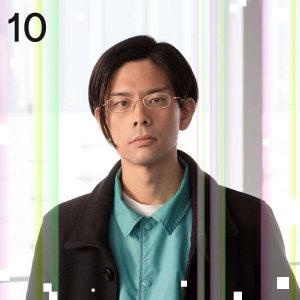
Born in 1992, based in Tokyo, Japan.Yamauchi graduated with an MFA in New Media from the Tokyo University of the Arts Graduate School of Film and New Media in 2016. His latest solo exhibitions include MAM Project 030 x MAM Digital:Yamauchi Shota (Tokyo, 2022), Where is EIZO-ZIMA going? Where are we going¿ (Taipei,2022) and Medium and Dimension: Apparition (Tokyo, 2023); along with group show participation in Roppongi Crossing 2019: Connexions (Tokyo, 2019), D.T. Suzuki: Life= Zen=Art (Tokyo, 2022), and Ars Electronica Festival 2022 (Linz, Austria, 2022). Recipient of the TERRADA ART AWARD 2021 Kaneshima Takahiro and Audience Awards, and an Excellence Award in the Art Division of the 25th Japan Media Arts Festival (2022).
2024
Video installation
8’29”
The Crystal World by Shota Yamauchi offers a fresh perspective on J.G. Ballard's mystical and speculative novel bearing the same title. Centered on the “Golden Mean,” it symbolizes a state of equilibrium that transcends opposing forces such as life and death or stillness and motion.
The 3D computer graphics in this work depict the story of the world's beginning and end. Similar to our reality, seemingly unrelated events transform and interrelate, creating a grand cycle. Whereas J.G. Ballard's vision of forests and human bodies adorned with crystals in suspended animation—neither alive nor dead—redefines happiness, Shota Yamauchi shifts the focus from traditional notions of wealth and prosperity symbolized by “gold” to an exploration of happiness through a more measured appraisal of its value. The theme revolves around finding contentment not in pursuing material wealth but in the equilibrium and harmony it embodies.
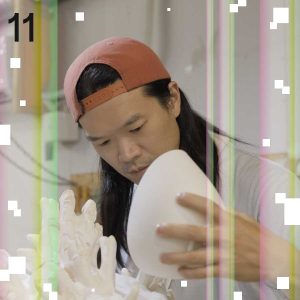
Chen-Yu Chen now lives and works in Taipei. His works examine the landscapes under the construction of digital industrialization and globalization of Capital, and the inter-activities between humans, commodities, and images. Working with moving images, objects, and installations, his practice often juxtaposes various media and examines how beliefs, desires, and anxieties are materially distributed in social production. His works, on the one hand, depict the phenomena created by re/production, consumption, and extraction, on the other hand, they explore the interpenetrative relationship and boundaries between humans, objects, and the environment.
2024
gesso, clay, fabrics, resin, wax, metal
How do we imagine the body—our own, others’, the body as an object, or the gendered body? Social media images blend the material of identity politics, making the understanding of the body a sticky, dynamic interplay of ideologies. The transformation of the body is heated by the mediated process of dopamine transmission, melting like sugar—sweet and sticky, as promised. With a flick of a finger or two, we can gather and craft a magnificent cotton candy in any form. Just like the animal-shaped clouds projected by our imagination, they are a mix of sweet granules and saliva-coated fantasies.
The narrative of fleeting excitement spills over the screens, pouring out various potential fluids/solutions, submerging everything around. Different bodies become wetland sculptures of imagined forms, testing their stickiness—how thick and ornate they can be layered, or how quickly they will dissolve.
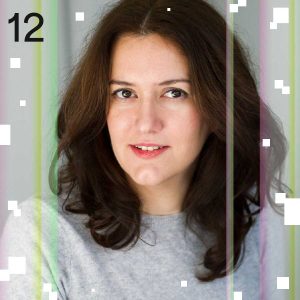
Aleksandra Jovanić is an artist and programmer from Belgrade, Serbia. She holds a doctorate in Digital Arts and a BSc in Computer Science. In her research and artistic practice she combines various media, mainly in the field of interactive art, art games, and generative art.
Jovanić’s recent works focus on the aesthetics of data visualization and optical illusions, as well as explorations of accepted concepts of truth and reality. Her work has been exhibited internationally in exhibitions at Unit London, Feral File, Vellum LA, ArtBlocks, and ArtBasel.
As an associate professor, she currently teaches at all three levels of study, at the Faculty of Fine Arts in Belgrade, at master studies of the Faculty of Applied Arts, and at art doctoral studies at the University of Arts in Belgrade.
2024
video
03'00"
Latitudes is a series of infinite animations in which a number of long extruded shapes travel in set directions with only minimal deflections. On their journey, the shapes cross over one another while occasionally encountering loops, beams, and numbered asteroids. Where are they going? Who are they? Will their fall or race ever end? Where is the finish line?
[…] unwound in continuous, parallel, straight lines that mean nothing beyond themselves in their constant flow, never meeting, just as we never meet in our constant fall […]” - The Form of Space, Italo Calvino
2024
video
03'00"
The positive and negative spaces are making a reference to life emerging through cracks in the concrete. The active area is a block of hand-painted gradient color and an undulating cluster of plant-like organisms.
2024
media video
03'00"
“Billowy bodies with celestial impressions heaping onto one another; spreading, shifting, drifting.” from A Meditation on the Endless Appeal of Clouds in Artby Charmaine Li
A peculiar connection between various latent states and billowing bodies is traced; between the figures we see in clouds and pseudo-random configurations we recognize as clouds.
Although algorithms in generative art lend themselves to creating an infinite variety of latent images, latent images are more commonly associated with film development in analog photography as an “invisible configuration of silver halide crystals on a piece of film after exposure to image-bearing focused light” — when the image has been exposed, but not yet revealed.
*DAFT x VolumDAO outdoor screening project
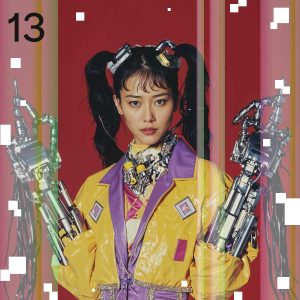
Emi Kusano, a Tokyo-based multidisciplinary artist, creates hyper realistic representations of collective and individual memories using AI technology. Her work, gracing the cover of WWD Japan and featured in Christie's and Gucci auctions, has been internationally exhibited at venues like the Saatchi Gallery, 21st Century Museum of Contemporary Art, Kanazawa, and Grand Palais Immersif. She is also known as a former creative director and co-founder of Japan's first Web3 anime studio, "Shinsei Galverse".
2023
Video
05'00";05'31"
Morphing Memoryseries reimagines Tokyo street fashion history and analyzes the connection between AI and memory. Based on Kusano’s “Neural Fad” post-photography collection, this video series visualizes the youth's nonexistent rebellious spirit and seamlessly transitions through eras. Detailed camera work and dynamic movement immerse viewers in digital scenes, accompanied by music that captures the unique atmosphere of fashion from different times.
Before the digital era, local magazines and TV were the catalysts for youth movements, shaping the Moga and Mobo of the 1940s to the Japanese hippies known as the Fūten Tribe, the Karasu Tribe of the 80s, and the Gyaru and Decora fashion of the late 90s and early 2000s. Amid today’s information overload and mass fashion consumption, this artwork attempts to reconsider AI’s role in reviving the history of street style once shaped by localized media.
*DAFT x VolumDAO outdoor screening project
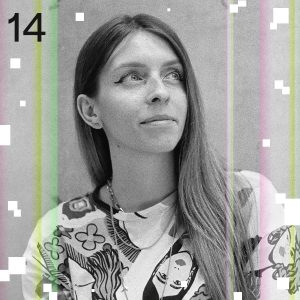
Driven by what she calls the “metaphysical act of imagination,” Tau’s practice explores the transformation of cityscapes into both utopian and dystopian realms, filtered through subjective memory and emotional interpretation. A fascination with photography began early for Tau, who grew up in Vilnius, Lithuania documenting the shifting post-Soviet world through her grandfather’s Lomo LC-A camera. This early exploration of color and texture evolved into a broader dialogue between the physical and digital worlds, which continues to shape her artistic approach today.
By training her own AI models – which she views as personal tools akin to a painter’s brush – Tau breathes life into cities long past, akin to the breath of gods in ancient creation myths. Her art captures the symbiotic relationship between human memory and AI, mirroring the interconnectedness of the Chimera’s organs, where technology becomes an extension of human perception.
2021-2022
video
06'26"
In Consciousness Horizons, Ivona Tau explores the relationship between memory, technology, and emotion. This generative AI series transforms personal photography into fluid landscapes, reflecting the fragmented and ambiguous nature of urban life as remembered and felt. Works like Winter Evening, Post Dawn, Sunset, Before Dusk, and Supernova evoke the mythological essence of the Chimera, with multiple realities woven together at the intersection of memory and machine.
Filtered through subjective memory and emotional interpretation, Tau’s hybrid process—using her own AI models as personal tools akin to a painter’s brush—breathes life into cities long past. This process investigates the tension between chaos and order, digital and organic. Inspired by artists like Man Ray, Dora Maar, and David Lynch, she creates immersive pieces that examine the evolving connection between society, nature, and technology.
*DAFT x VolumDAO outdoor screening project

Sasha Stiles is first-generation Kalmyk-American poet, language artist, and AI researcher working at the nexus of text and technology, known for her pioneering experiments with generative literature and blockchain poetics. Her practice refracts heritage and tradition through disruptive explorations of creativity and consciousness, probing the role of human voice in a machine age. Stiles has been recognized by MoMA, Art Basel, Christie’s, NPR, Artforum and Gucci, and received the first AI in Art Award of Distinction from the Prix Ars Electronica. A graduate of Harvard and Oxford, co-founder of theVERSEverse, and longtime poetry mentor to humanoid android BINA48, Stiles lives near New York City with her husband and studio partner, Kris Bones.
2024
video
03'00"
AI-powered poetry translated into Cursive Binary, a proposed language for human-machine collaboration, performed by Stiles, with music by Kris Bones.
2024
video
03'17"
Unique media-rich palimpsest of A Restless Mind, an original poem written and performed by Stiles and her AI alter ego, Technelegy, using a suite of next-gen poetic devices, augmented with electronically enhanced spoken word and music created in collaboration with Kris Bones. The third work in “FOUR CORE TEXTS: HUMANIFESTO AND OTHER POEMS”, A Restless Mind meditates on the boundless landscape of consciousness, the probabilities of emergent sentience, and the constant struggle for clarity and calm in the vortex of modern existence. It is inspired in part by a line by Emily Dickinson: "The Brain—is wider than the Sky—" (c. 1862). From "FOUR CORE TEXTS: HUMANIFESTO AND OTHER POEMS," a quartet of transhuman poems powered by the ever-evolving technology of language.
*DAFT x VolumDAO outdoor screening project
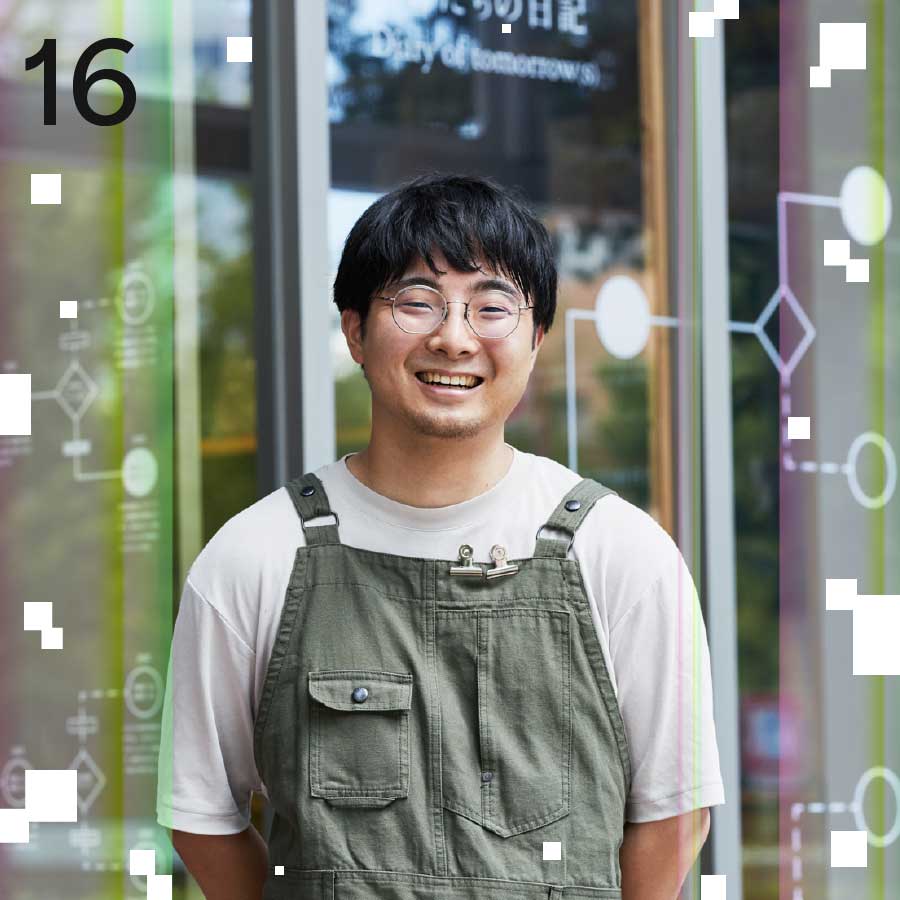
Tomo Kihara is an artist and game developer creating experimental games and public installations. His work often takes the form of embodied playable thought experiments that invite everyone to explore new questions around socio-technical issues through play. Recent projects focusing on AI's social impact have been developed in collaboration with institutions such as Waag Futurelab (Amsterdam) and the Mozilla Foundation (USA). His works have been exhibited at the Victoria & Albert Museum (London, 2022) and the Asian Art Museum (San Francisco, 2024).
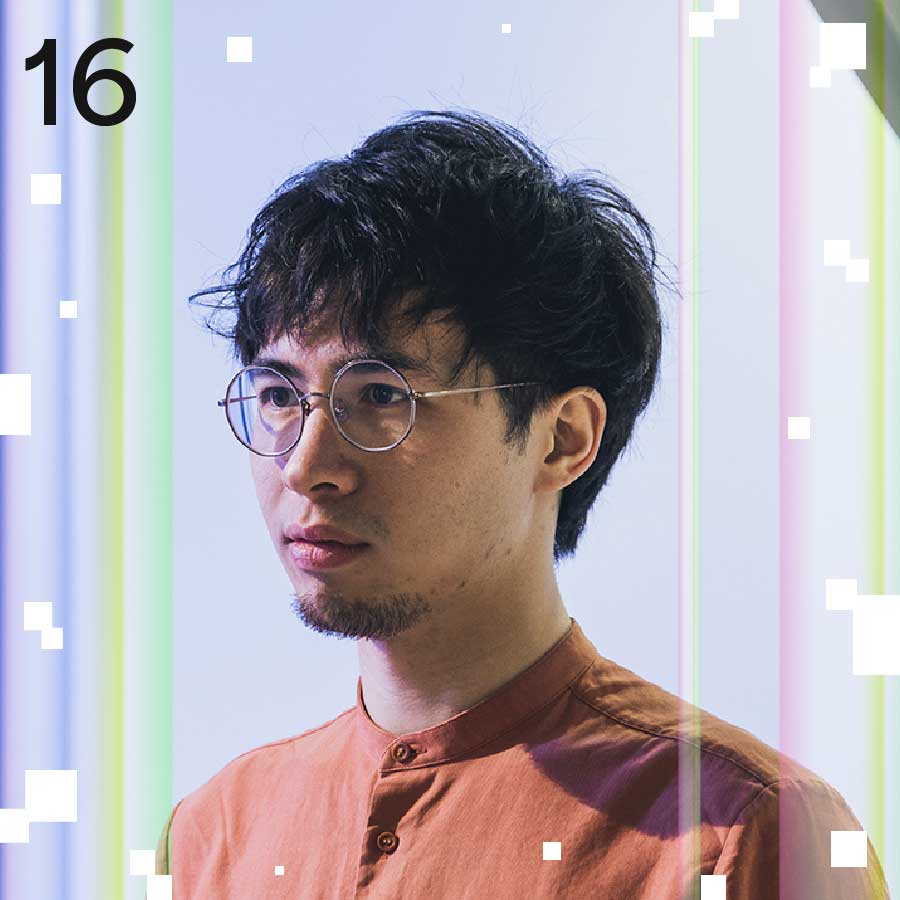
Daniel Coppen (GB) is an artist and designer exploring the nature of relationships between society and technology through the medium of play. Operating as Playfool, together with his partner Saki Maruyama, his practice comprises objects, installations, and multimedia productions, which emphasize play's experimental, reflective and intimate qualities. Playfool’s works have been awarded in both the Dezeen Award (2021) and STARTS Prize (2024), and have been exhibited at the Victoria and Albert Museum (London, 2023) and Ars Electronica (Linz, 2024).
Co-created with Daniel Coppen (Playfool)
2023
LED panel, AI-model, computer, button, pressure-pad
How (not) to get hit by a self-driving car is a game installation that challenges people to cross a virtual street undetected by an AI-powered self-driving car simulation. Players, each marked with a pedestrian detection score determined by the algorithm, must cleverly disguise themselves to reduce their score and avoid detection. Successful evasion exposes both the system's blindspots and inability to recognise diverse individuals, like children or wheelchair users, highlighting the risks posed by these flawed algorithms in real-world scenarios. Each victory generates edge case data showcasing the AI's biases and flaws. Upon winning, players can choose to contribute the data to improve the model or delete it, raising questions about the trade-offs in developing these technologies. The project addresses geographical bias in AI data collection by organizing global exhibitions to engage a wider range of demographics.
Credits